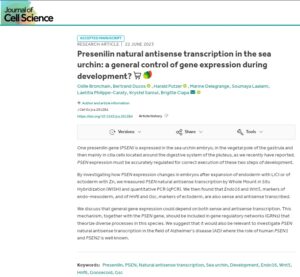Journal of Cell Science. 2023 Jun 22 ; jcs.261284. doi: 10.1242/jcs.261284.
Odile Bronchain, Bertrand Ducos, Harald Putzer, Marine Delagrange, Soumaya Laalami, Laetitia Philippe-Caraty, Krystel Saroul, Brigitte Ciapa
https://doi.org/10.1242/jcs.261284
Abstract
One presenilin gene (PSEN) is expressed in the sea urchin embryo, in the vegetal pole of the gastrula and then mainly in cilia cells located around the digestive system of the pluteus, as we recently have reported. PSEN expression must be accurately regulated for correct execution of these two steps of development. By investigating how PSEN expression changes in embryos after expansion of endoderm with LiCl or of ectoderm with Zn, we measured PSEN natural antisense transcription by Whole Mount in Situ Hybridization (WISH) and quantitative PCR (qPCR). We then found that Endo16 and Wnt5, markers of endo-mesoderm, and of Hnf6 and Gsc, markers of ectoderm, are also sense and antisense transcribed. We discuss that general gene expression could depend on both sense and antisense transcription. This mechanism, together with the PSEN gene, should be included in gene regulatory networks (GRNs) that theorize diverse processes in this species. We suggest that it would also be relevant to investigate PSEN natural antisense transcription in the field of Alzheimer’s disease (AD) where the role of human PSEN1 and PSEN2 is well known.
Keywords: Alzheimer’s disease; Development; Endo16; Goosecoid; Gsc; Hnf6; Natural antisense transcription; PSEN; Presenilin; Sea urchin; Wnt5.